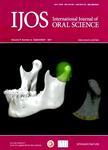Interaction between Schwann Cells and Osteoblasts In Vitro
Interaction between Schwann Cells and Osteoblasts In Vitro作者机构:Bone Biology Research Laboratory Children's Hospital Boston Harvard Medical School Boston USA Division of Oral Biology Tufts University School of Dental Medicine Boston USA Department of Developmental Biology Harvard School of Dental Medicine Boston USA
出 版 物:《International Journal of Oral Science》 (国际口腔科学杂志(英文版))
年 卷 期:2010年第2卷第2期
页 面:74-81页
核心收录:
学科分类:1003[医学-口腔医学] 1002[医学-临床医学] 100210[医学-外科学(含:普外、骨外、泌尿外、胸心外、神外、整形、烧伤、野战外)] 10[医学]
主 题:osteoblasts Schwann cell co-culture proliferation differentiation
摘 要:Aim Given the well-known properties of Schwann cells in promoting nerve regeneration, transplanting Schwann cells into implant sockets might be an effective method to promote sensory responses of osseointegrated implants. The aim of this study was to evaluate the interaction between Schwann cells and osteoblasts. Methodology Schwann cells derived from the sciatic nerves of neonatal rat were co-culured with osteoblasts using Transwell inserts. The proliferation of Schwann cells in the co-culture system was evaluated using methylthiazol tetrazolium (MTT) colorimetric method. Moreover, the secretions and mRNA levels of brain-derived neurotrophic factor (BDNF) and nerve growth factor (NGF) were measured by enzyme-linked immunosorbent assay (ELISA) and quantitative real-time PCR, respectively. In order to test the effect of Schwann cells on osteoblasts, alkaline phosphatase (ALP) staining and Alizerin red staining were performed as well. Results Schwann cells, which were co-cultured with the osteoblasts, showed an intact proliferation during the observation period. Moreover, the gene expression and synthesis of BDNF and NGF were not impaired by the osteoblasts. Meanwhile, co-cultured osteoblasts exhibited a significant increase in the proliferation on day 3 and 6 (P〈 0.05). Co-culture of these two types of cells also led to a more intense staining of ALP and an elevated number of calcified nodules. Conclusion These findings demonstrate that, in the in vitro indirect co-culture environment, Schwann cells can maintain their normal ability to synthesize neurotrophins, which then enhance the proliferation and differentiation of osteoblasts.



